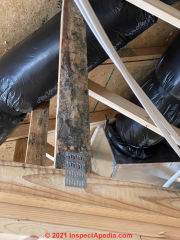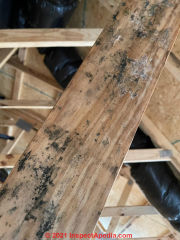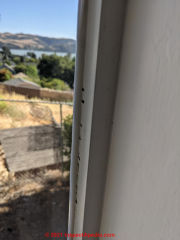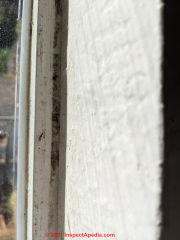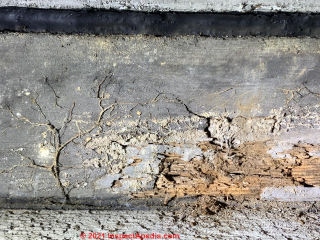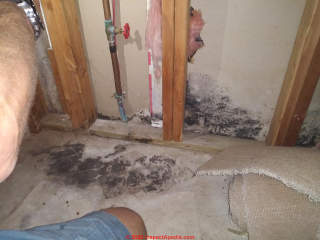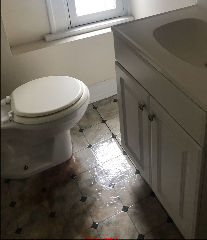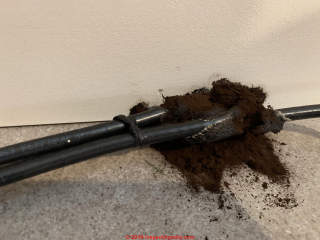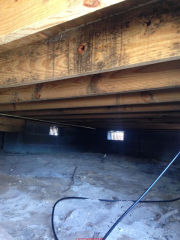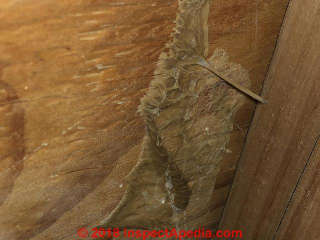 Mold Contamination Guide FAQs #4
Mold Contamination Guide FAQs #4
Remediating mold contamination
- POST a QUESTION or COMMENT about how to find, test for, remove, clean up and prevent mold contamination in buildings
Frequently-asked Questions & Answers about indoor mold contamination:
Questions about how to identify and evaluate indoor mold contamination and what to do about it.
Page top: construction adhesive mistaken for toxic mold growth. More examples of this mistake are on this page.
This article series explains how to recognize mold, how to test for unsafe mold, how to clean up or remove mold, how to prevent mold contamination in buildings, and what mold related illnesses and symptoms have been reported are all discussed in depth.
InspectAPedia tolerates no conflicts of interest. We have no relationship with advertisers, products, or services discussed at this website.
- Daniel Friedman, Publisher/Editor/Author - See WHO ARE WE?
FAQS: Remove, & Prevent Mold Contamination
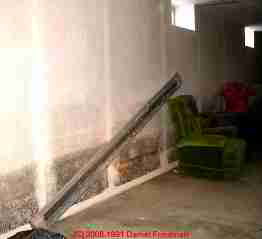 These questions & answers were posted originally
These questions & answers were posted originally
at MOLD CONTAMINATION IN BUILDINGS - topic home. Please be sure to review the guidance given there.
[Click to enlarge any image]
A proper "mold contamination inspection" inspection includes
- Inspection of the entire building, outdoors and inside,
- a review of all building leak and flood history,
- construction details that suggest areas of highest risk of a hidden problem,
- a modest or limited exploration of the most at-risk areas for hidden mold,
- and a remediation plan that tells you where there is mold cleanup needed, to what extent, how it should be done, level of containment needed, cause, and
- steps to prevent future mold growth;
- for a large and more costly cleanup it includes checks that permit testing after the cleanup to assure that the cleanup was complete and proper and that some idiot didn't contaminate other building areas.
On 2021-05-31 by mak.church (mod)
@financialplans, Please see this article: How to Identify Harmless Black Mold on Indoor Surfaces
In particular, the article refers to 'interrupted mold growth' where the adjacent lumber is not affected, as well as other things to look for to identify properly. I hope this helps and if you have more questions, please ask.
Keep in mind that even though it's quite obvious that the mold on your lumber was present before those trusses were built - so may have been a cosmetic mold from the lumber yard, you should know that exposed to damp or wet conditions, other fungal genera/species might begin to grow on the same surfaces, even atop the original mold as a parasite.
On 2021-05-30 by financialplans
@financialplans,
follow up post with picture - anything to be concerned with?
On 2021-05-19 by Lila
On 2021-05-19 by Lila
Hi there, no I haven't I did read online that it could be old honey from an old hive but its from the whole window sill, like the sides too. I will send some pics, also a next door neighbor let me borrow a moisture meter and it goes above 50 along all of our sills but he said it could be false readings due to a potential metal frame, our houses however are identical and when we tested his sills they didn't go off.
Also he said that there would have to be a source of moisture and if there wasn't there couldn't be any mold. So if there was water damage, but then it dried out would the mold never come back as long as it never got moist?
Thank you so much, I also think I might give in and pay for it to be sampled...
On 2021-05-12 - by (mod) -
@Lila,By any chance have you heard bees buzzing or seen honey bee activity around the wall?
Else there seems to be water leakage into the building walls where it is leaching out coloured material from building materials there: sheathing board, building paper, asphalt-impregnated felt, or other building materials.
You might suggest to the landlord that unless the leaks are found and fixed she's risking expensive rot, insect damage, mold contamination, even potential damage to and unsafe electrical wiring.
On 2021-05-12 by Lila
Thank you so much for your response, so I tried to wipe it away to see what it was, and its VERY sticky/tacky not runny at all. It was like sap or tar, then about a few weeks after I wiped it more replaced the area I wiped. I have no idea if there is/was water damage when we first moved in a little over a year ago there was no mold present anywhere and now all the windows have it, but only this one has this weird oozing stuff. With the other windows we just use a household cleaner every week and clean the window sills and that has kept it under control.
I am only really worried about this weird ooze!
I can't open up the walls to check (renting) but I can tell the landlord, but what if they tell me that I just need to keep the area cleaned?
I don't mind doing that, as long as I know my family is not in any significant ( I know mold is everywhere and our immune systems are designed to deal with it) risk.
Thank you so much, I am so grateful that you guys provide all this information for us laymen!
On 2021-05-09 - by (mod) -
@Lila,Depending on the age of the material used to construct your building and what the material is there are several things I can reach out as black there are water leaks or condensation problems in the building wall or ceiling cavity. I can't offer an authoritative opinion about the toxicity of the black liquid in your photo but I can advise the weather there's water in the building significant risk of hidden mold contamination.
It's worth exploring the walls to find the extent of hidden mold which of course must be removed along with any wetter water damaged insulation or other material, and the source of the leak needs to be found and corrected. You can warn your landlord that the longer this league continues the greater will be the cost of the repair. And of course there are potential health concerns if there's a mold reservoir.
On 2021-05-09 by Lila
Hi there, I moved into this house and after a few months noticed mold growth around all windows. It looks like the landlord has cleaned and sealed over a previous mold issue instead of actually fixing it. I also found this weird black ooze coming from one of the window sills and it's disturbing to me. Does anyone know what this could be? Also how do I approach my landlord about it? I am certain they don't want to spend a penny to do anything. I'm just worried about my families health. Thank you so much.

On 2021-04-06 - by (mod) -
@El Maco, Thanks for the question and photoI see both rot and also some insect damage; If on closer inspection you see what is almost certainly "dirt" in the area of rot, there is a termite problem - making it worth getting help from a licensed Pest Control Officer (PCO)
On 2021-04-06 by El Maco
Hi, this is in our heated basement and the lumber is directly in contact with the ground from the outside (open crawl area).
This is the most bottom wood and the issue continues from the beginning of the lumbar to almost to the end of it but is interrupted about an inch away from the end. It appears to me that its a true dry rot caused by fungus. What do you think? Does it need to be cleaned or left alone?
On 2021-04-06 - by (mod) -
@Lin,When there is a history of leaks into the building or high indoor moisture it would be no surprise to find mold growth on mold friendly surfaces such as wood and drywall. The fungi that you see are the fruit in body of mold.
On 2021-04-06 by Lin
we very much do have it inside. Finding this made me wonder if it came inside from outside or what. Here’s one from inside.

On 2021-04-04 - by (mod) -
@Lin, if you have water actually entering the building structure or basement or a crawlspace and you definitely want to look in those areas for mold contamination.I agree that finding mushrooms growing on or in your building is an indicator of wet conditions.
On 2021-04-04 by Lin
Found this guy along with actual mushrooms and rhizomorphs along our foundation outside. I think he’s related to the rot inside?
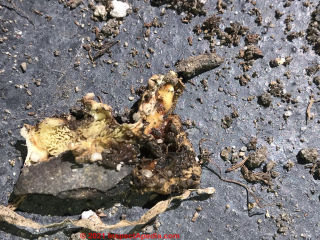
On 2021-01-30 - by (mod) -
AnonI can't say how much mold is in your rental unit but that blurry photo looks like mold on plywood or paper -I can't quite make it out, nor can we say if those structural components are indoors or outdoors
On 2021-01-30 by Anonymous
Is my rental filled with black mold
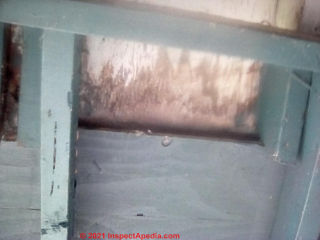
On 2021-01-07 - by (mod) -
SarahPlease find your question and my detailed reply and our discussion about how much investigating and demolition to do in evaluating the risk of mold below a cabinet base, now at the Reader Q&A section near the bottom of the article above on this page. You may need to clear or refresh your browser cache to see the updated page. We welcome your further photos, comments, questions.
On 2020-11-19 by (mod) - lead doesn't cause mold but water leaks do
 Toot
Toot
That looks like extensive mold contamination to me. Watch out: In addition if the wall is that moldy and has been wet there's a good chance that there's more mold contamination in the wall cavity. You need to remove the mold everywhere that it is present which probably is going to require some invasive inspecting of the walk out and of the underside of the floor below. Lead in water would not cause the mold growth in your photo but, of course, a leak (water) in that area would.
On 2020-11-19 by Anonymous_tootall
Hi there, we had an incident where hot water leaked from a bathroom faucet upstairs for at least a week while we were away.
We actually had a city inspector come to our home recenbtly because they will be changing the pipping supplying water.
He tested and said the lead content in our water was 5 times the normal rate (24 mcg/litre).
The city inspector wondered if maybe the high concentration of lead was causing this brown discoloration.
Any help please. Thank you
On 2020-11-17 - by (mod) -
It is definitely mold, and most likely more than one genera/species. "Black or not" mold is not important.
On 2020-11-17 by Kylie
Hi, I am wondering if anyone thinks this is mold? Or black mold?
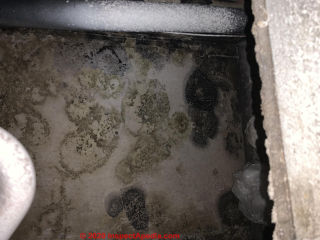
On 2020-11-05 - by (mod) -
Elan
As it's painted-over I'm not sure what we're seeing; debris, a fungus, moss, something else; there could be rot as well, but at the right side of the photo whatever that was before it was painted, it was atop the wood framing, not inside it.
On 2020-11-05 by Elan
Any idea if this is mold or dry rot? It’s hard to get a better picture as it’s pretty high up but found this while trying to find the source of an odor.

On 2020-09-16 - by (mod) -
It's not fireproofing it's flame dissipator to add color and reality; Forgive me Sarah but all of this seems to me enormously out of proportion; there's no mold fish in those waters.
On 2020-09-16 by Hammers Galore
@Sarah,
So that is fireproofing between the brick/exterior between the firebox and the fireplace. The fiber is a fiberglass mesh which in the 80's and 90's was common or earlier. If you have a feeling or concern of mold in that mesh...put on a fire in the fireplace and it will completely dry out all of that. No mold will survive after a few hours of a warm fire this winter in that material as there will be no moisture.
Warning: inspect your chimney flue before you turn it on since you never used it. (chimney inspection + cleaning) as a true inspection cant be checked if the flue is not clean.
Or...
Your air handler ("a/c") is technically a built in dehumidifier.
On 2020-09-15 by Anonymous
Dan, thank you so much! You are a gem! I don't know how you keep up with the onslaught of questions you receive on this website in various categories. Your commitment to helping people with a wide variety matters is impressive and an incredible public service. Thank you!
On 2020-09-15 by (mod) - don't mistake thick house dust for mold
Sarah
We have found mold in fiberglass that has been either wet or has been exposed to high levels of airborne mold.
But at a gas log fireplace that's not likely;
In any event the total volume of material is trivial;
Beware of asking for help from consultants or you can run into the OPM problem: you make the consultant nervous; she decides to spend a lot of your money to reduce HER risk - it doesn't cost her a dime.
Details are at OTHER PEOPLE'S MONEY
On 2020-09-15 by Sarah - dusty fireplace isn't moldy
 Thank you so much! If you are confident of that, we'll clean with care. If you have any doubt (I realize you're judging based on a photo, please let me know. But I see from other Q&A's (which are always very illuminating) that you don't hesitate to say if you think something looks like mold, and that you are also willing to say it's not clear. So I have a lot of faith in your honesty and limitations of making determinations from a verbal description and photograph. So with all of that said, if we wanted to make absolutely sure, would you have concerns about us turning the fireplace on with the idea that if there were any bit of mold it would burn it, or would it be ill-advised to do that since there's so much dust and it could catch on fire in a bad way? Thank you!
Thank you so much! If you are confident of that, we'll clean with care. If you have any doubt (I realize you're judging based on a photo, please let me know. But I see from other Q&A's (which are always very illuminating) that you don't hesitate to say if you think something looks like mold, and that you are also willing to say it's not clear. So I have a lot of faith in your honesty and limitations of making determinations from a verbal description and photograph. So with all of that said, if we wanted to make absolutely sure, would you have concerns about us turning the fireplace on with the idea that if there were any bit of mold it would burn it, or would it be ill-advised to do that since there's so much dust and it could catch on fire in a bad way? Thank you!
On 2020-09-15 - by (mod) - dust & debris on mineral wool in a gas log fireplace
Sorry for the confusion Sarah but comments that include a link or a picture await moderator approval.
Your photo shows dusty dirty mineral wool insulation often used to create a more-attractive flame in a gas-log fireplace.
Mold growth on fiberglass or other decorative or flame-control materials at a gas log fireplace would not be likely if the fireplace is used regularly as that ought to keep that area dry. Mold needs moisture.
On 2020-09-15 by Sarah
Sorry, as well. I noticed the notice about awaiting moderator approval after the second post. looking forward to your assessment/opinion of the ... dust?... mold?
On 2020-09-15 by Sarah
Just tried to leave a question w/a pic, but it disappeared after I hit "comment," so trying again: Gas fireplace we never use. Bought the house 2+ yrs ago. Don't know if former owners used it (we think they did).
Past few weeks notice a subtle musty smell in the area of the fireplace. Looked in w/a flashlight and saw what looked like mold. Husband said it looked like heavy dust build up on fiberglass and that since there's no moisture source, mold didn't make sense. However, given the musty-ish smell, the look of it, the fact that we never use it and have never cleaned it, and that air flow is limited (we never open the doors though there are space around it where there is some air exchange, I'm concerned. Attaching a pic to see what you think. Thank you for your help.
Noticed a stuff smell around a gas fireplace we never use. Bought the house 2+ years ago, so it's been at least that long.
It has a lot of fake stuff in it we want to remove. But after noticing the subtle smell and looking inside w/a flashlight through the glass, I noticed some areas of concern. My husband said it's dust that's built up on fiberglass and it couldn't be mold because there's no moisture source.
But I'm concerned. As I said, we never use the fireplace so there's been no heat to kill anything that might be growing in there, we never open the doors, so air flow is limited, and we haven't cleaned inside for 2+ yrs (and who knows what the prior owners did or didn't do).
Before removing everything (which we've want to do since we don't uses it), we want to know what we might be getting into especially since mold would not be good to disturb willy nilly and I'm highly allergic to it. I'm attaching a couple of pictures to see if you have an opinion about whether this looks like heavy dust or mold. Thank you for your help.
On 2020-07-26 by Nicole
Sorry to bother you again. Could you elaborate on your last sentence please? I didn’t understand. As you know, we have been down the professional mold remediation road recently. The bathroom with the purple wall is off of a bedroom that had 2 closets with Ulocladium. A furnace room area had Stachybotrys.
Three out of four of our family are extremely sensitive to mold and have been sick with the “classic symptoms” for years. We are thinking about just having the bathtub/showers torn out and replaced so we can be sure any leaks are seen and repaired. In your opinion, should these areas be removed and the areas treated with professional mold remediation with containment etc?
The other option is the typical general contractor route. I’d rather start out right instead of having a contractor open up the walls, to find something that none of us should be exposed to, but we don’t want to be reactive either. Thoughts?
If possible could I send you the lab report, inspection report and recommendations from the Biologist/Environmental Hygienist that did the inspection on our recent water issues? I’d like to know if you think it was an intensive inspection. Thanks again!
On 2020-07-26 - by (mod) -
Unfortunately when you see a fungus growing out of a wall you can pretty much bet that there's going to be more wet material and possibly rot inside that area. There's nothing saved by leaving that with material in place. It's going to need to be removed until you if we moved everything that's wet and course fixed the leak.
The later photos you included show rusty metal corner bead or strips used behind drywall - all related to bathroom moisture; rust isn't mold, but it is a moisture or water indicator that can mean that nearby materials such as paper or wood, if wet, could host mold growth.
None of your photos themselves show significant volumes of mold - more than 30 sq.ft. that would require professional remediation. Investigate further in the worst or most-suspect area first.
On 2020-07-25 by Nicole
Thank you for your reply. Your site is so thorough and much appreciated. Regarding the fungal growth - was that looking at the purple wall only? I sent photos of the other bathroom, but unsure if you received. I attached one here.
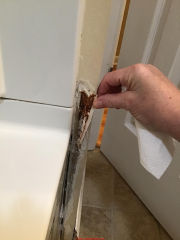 ...
... 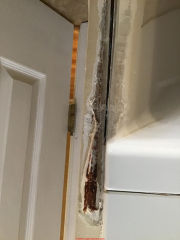
On 2020-07-25 - by (mod) -
Looks like a fungal growth - investigate to follow the water to be sure you're not leaving damage.
On 2020-07-25 by Nicole
Hi, we discovered a wet spot in our bathroom next to bathtub/shower. The paint was bubbly and peeling. There is plaster with a board behind it. The first picture shows what it looked like after peeling off the paint. There are dark spots in the plaster and the plaster was wet and is now crumbly after drying.
The other photos show what I see behind the plaster after tearing off part of the drywall tape. The colored part is on the tape and the corner piece. After opening this up more, I can feel the part of the wall right next to tub is wet too.
The single photo of the purple wall is in a different bathroom. This is discolored but not wet.
I hope you can give me an idea of whether this is serious or not. We just had 3 places in our home fixed that had mold from water damage remediated and rebuilt. Two were the toxic mold for which we left the house for 2 1/2 weeks while it was being torn out and remediate.
Just under $10,000 spent on those 3 areas, and we’ve only been back in the house 2 weeks and now these spots. Another mold test is $500. Thanks in advance for your help.
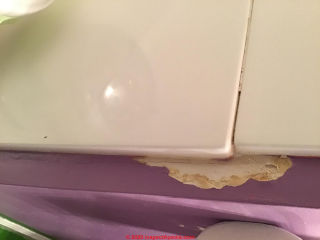
On 2020-07-20 - by (mod) -
 Jona
Jona
First you want to be sure that your inspection is thorough enough that there's no chance that you're leading a mold Reservoir in the building that has to be dealt with in a second or do over job. For example if water enters the bottom of a partition wall that is covered in drywall the wall cavity May become a mold Reservoir. So I would inspect the interior such cavities by cutting and inspection opening in the most suspect area near the bottom of such walls.
Testing for mold is never complete, and cannot identify all of the molds that are present, and is not diagnostic or prescriptive. It's interesting and fun and of course makes a little bit of money for the test people. It doesn't change what's needed one bit.
Remove the mold, clean the exposed surfaces, and find and fix the cause of any leakage.
If plywood subfloor is Black from prior leaks and mold contamination but now is clean and has Thoroughly dried, it's not a measurable mold Hazard as long as the plywood is not delaminating or damaged. You might for peace of mind like to apply a fungicidal sealant.
Please take a look at the Index to Related Articles on this page and you will find details on the proper way to clean up mold and wood surfaces and use of sealants.
On 2020-07-20 by Jona S.
Hi There, We had some water damage happening and pulled up the floor to find this. Some of the water went under the floor into the closet of the next room. The wood is discolored and there was a musty, moldy smell. The mold guy tested the carpet, and it was positive for Trichocladim, which apparently can cause allergies in some people.
He also did an air sample that did not show elevated mold spores. However, the test he did was in the bedroom and that was before we pulled up the bathroom flooring. We rented an airscrubber and wore goggles and mask and gloves to remove the flooring and ran the airscrubber all weekend.
The sub floor just looks dark, you can't see specifically mold on it and the wood is not crumbling or anything, still seems stable, just discolored. We opened the ceiliing and there is minimal discoloration under the floor but some darkness between the plywood floor and joists where it is nailed together (water probably came through the seams of the wood). Should we just clean with soap and water and let it dry?
Spray with bleach or vinegar? What should we do before we cover up the floor and repair with tile and grout and seal it? It seems the leak was either from faulty seal on tub wall between tile and tub, or bad caulking between tub and floor (kids get out of the shower soaking wet sometimes). Any help is greatly appreciated!
On 2020-06-28 - by (mod) -
Glad to assist. Working together makes us both smarter.
On 2020-06-28 by Cindy Tiemeyer
Thank you for the fast reply and for clarifying for me, was quite a dilemma.
Thank you ... for the clarification, appreciate it.
On 2020-06-26 - by (mod) - how to figure the age of mold contamination
Tammy:
yes, from surrounding clues we can get a general idea of how long leaks or other conditions that caused mold growth have been present in or at a building.
Please find your question and my detailed reply, now near the bottom of
AGE of MOLD GROWTH - inspectapedia.com/mold/Age-of-Building-Mold-Growth.php
and let me know what you think;
On 2020-06-26 - by (mod) - Mold in a roof cavity
Cindy Tiemeyer
Mold in a roof cavity is not likely to directly "break down" asphalt roof shingles but mold damage can increase the leak risk.
If the roof sheathing on your home is rotted and soft future leaks are much more likely, if for no other reason than the shingles may blow off the roof, lacking sound nail base, or because a depression in the roof surface, sagging over bad decking, may become a leak point even if the shingles themselves have not yet been visibly damaged.
On 2020-06-26 by Tammy
Is there any way to tell how long this mold has been in our home. We are renting and have only lived here for eight months, we never knew this water valve was under the stairs until we told our landlady yesterday that our children's bedrooms have mold growing in them.
She said she has never had mold in the home before but the first place she went to look was . underneath our stairs if you're trying to blame us for the mold but this area is nowhere near the mold that's growing in our kids bedroom
Tammy said:
Is there any way to tell how long this mold has been in the house we are renting?
Our landlady is trying to say that there's never been mold before. We told her yesterday there was mold in our bed kids bedrooms and the first place she wanted to look was under the stairs. We never even knew this water valve was back there until she wanted to look there oh, so my husband called back there and the drywall is black, it's completely dry, and it is crumbling.
Mod reply: Tammy we deleted the nice photo of a young woman in a black and white checked bathing suit as I think you posted that by mistake.
On 2020-06-26 by Cindy Tiemeyer
Question...Had weatherization done in home. They sealed the bathroom vents and pushed up the vents outside.
Very bad mold issue, sheathing had to be replaced, shingles in a large area of back of roof, bi-level. Mold remediation was supposed to be done but was not.
1.6 years later, mold is growing in spots on sheathing including new sheathing, some on rafters.
I know that mold can lay dormant and be sporadic where it appears and that winter brings more moisture to attic.
Roof has a Ridge for ventilation. Problem is in 2 spots on sheathing it appears that the mold has broken it down, it s now leaking. Had roof inspection was told shingles good for another 5-6 years. Has the mold that broke down the sheathing compromised the integrity of shingles in those areas and cause new leaks? There seems to be no other explanation? Thank You.
On 2020-05-13 - by (mod) - mold on fiberboard or chipboard cabinet base
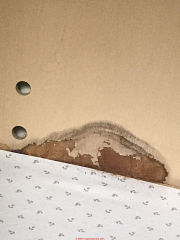 Kayla
Kayla
That looks like deteriorated fiberboard or chipboard, perhaps part of a cabinet, deteriorated paint - and probably a bit of mold around the edge of the paint; Look for hidden water damage and of course find and fix the leak.
On 2020-05-12 by Kayla
Hello! Does this look like mold to anyone? It Is located in the kitchen in a cabinet. Would appreciate any thoughts and insight. Thanks!
Hello! Can someone please let me know if this is mold? It is in the kitchen in a cabinet.
On 2020-05-02 - by (mod) -
Mold tests alone are not a reliable proof that there is no significant hidden mold reservoir. A thorough visual examination and history taking can support the conclusion.
On 2020-05-01 by Bruce
I have several office workers that believe mold is causing them health issues. Three rounds of sampling have indicated total fungal spore counts of <100. investigation found no possible water reservoirs or sources. outside sample showed insignificant spore counts. thermal imagining showed nothing suspicious.
i am using an emsl report that indicates by color acceptable, slightly elevated, elevated. they seem to be focused on the slightly elevated molds like alternaria @ 20. i can't seem to get them to understand there is nothing to remediate. they believe all these slightly elevated molds are the reason. how do you explain in terms they would understand without just firing them?>
On 2020-01-20 - by (mod) - don't get distracted by looking only for "black" mold
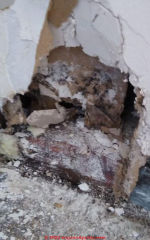 Stephanie
Stephanie
Take care not to be fooled by the "black mold" scare; of the millions of mold species there are molds of every imaginable color, and many of those that are harmful are not black but white, gray, green, red, yellow, orange, pink, etc. Some of the most-harmful molds that produce small spores breathed deep into the lungs (Aspergillosis) are light colored.
So the dark mold in your photo is a good indicator of wet love building conditions, but it may not be the most-serious health risk.
As you said you've had to move out of a moldy home, take care that you haven't accidentally brought moldy dust into the new home. Wash what can be washed, dry-clean or launder soft items.
On 2020-01-20 11:56:22.760509 by Stephanie
I entered only one of many places with black mold in my home. I have entire interior and exterior walls full of it. Lack of county inspection, maintenance from landlord, who is my father, faulty set up when delivered and a manufacturer default. The triple part of my home is the kitchen and is 10 to 12 inches shorter than is stated in the plan from the FLDMV.
My children and I had to leave in the middle of the night 2 weeks ago as I have gotten a chronic illness from exposure. Small county corruption at it's worst.
On 2020-01-06 - by (mod) - it's probably not mildew, but it's mold
Anonymous said:
hey, (mod) , read this article on mildew:
Moderator reply:
You might enjoy our mildew article series beginning at MILDEW REMOVAL & PREVENTION
and
in particular
MILDEW ERRORS, IT's MOLD
The Wikipedia article is in agreement with a popular if wrong opinion. Indeed mycologists are well aware of the broad popularity of mis-use of the word and some don't care. Some do.
Mildew is indeed two specific (and very different) members of the much larger mold family.
Why do we care? Using a less frightening (if wrong) word for the mold we find in buildings may serve to avoid scaring people into both wasted money and into being victimized by a fear-based price gouging by a mold cleanup service providers
Mildew is an obligate parasite, it only grows on living plants. Unless you are living in a house made of grape leaves, if you see stuff that looks like mold, it is mold, it's not mildew.
If you are looking to buy a car to drive up Highway 61, and I show you a boat, you'd better shop elsewhere unless you plan to stick close to the North Shore of Lake Superior, and to never leave the water.
Thanks for the comment.
On 2019-11-11 - by (mod) - crawlspace covered with "black mold" - no roof for 8 months
 In addition to the follow-up that we've already had by email, I want to add that ... "just mildew" is absolute nonsense.
In addition to the follow-up that we've already had by email, I want to add that ... "just mildew" is absolute nonsense.
There is no mildew in buildings.
Mildew is an obligate parasite that only grows on living plants. If you see mold it's mold. It's not mildew.
On 2019-11-11 by S Birch
This is the contaminated area
We have had a bad experience with a home contractor. We fired the builder, but the new construction home was left exposed without a roof for 8 months (give or take) before we fired him.
The crawl space is covered in what appears to be a black mold. The builder is insisting it is just "mildew" and completely safe, but we disagree. The joists are covered in it. It doesn't appear to be too bad on the subfloors (OSB).
Could this have happened from being exposed for so long? We are at a loss. I emailed pictures. The "mold" in question is dark colored and seems to be inside the grain of the wood and growing in circles and a linear pattern.
On 2019-09-17 by (mod) - culture plate shows green mold and 40 CFU/ml from under my sink
Looks like a couple of kinds of mold.
Keep in mind that 90% of molds will not grow in ANY culture whatsoever, so we're roughly 90% "wrong" when depending on cultures to identify mold. So I'm not sure what to make of a count of colony forming units. That's what fell on and liked the mold culture media.
Details are at MOLD CULTURE TEST ERRORS
The good news is it doesn't matter since the genera/species won't change the cleanup needed.
Remove the mold, fix the cause.
On 2019-09-17 by Steve - my culture test found mold
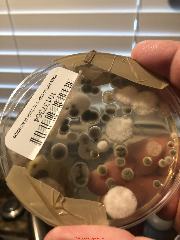 Green moldy stuff under sink This was under a piece of vinyl that was glued on top of the floor. There was a liver below it too.
Green moldy stuff under sink This was under a piece of vinyl that was glued on top of the floor. There was a liver below it too.
Thanks!
This is from the area under the sink. where I found the green stuff...I got a 40 CFU/ml with this mold.
[Click to enlarge any image]
I moved in a rental home in July - (7/22) noticed I started coughing. I thought it was the Summer cold and went about my business. I still had it a week later - went to doc in a box and got a ZPack and Prednisome script and it didn't even dent the cough. I went back - got a chest xray and all is good. Another round of prednisone - didn't help.
I had a master bedroom that had a stink in the room and they changed the carpet out and the stink went away - I waited about a week and I finally slet in there once I got my mattress delivered.
I slept in that room one night and when I let my dog out in the middle of the night, I was light headed - my legs were scratchy and when I woke up the next morning. Was feeling disorientated, dizzy, low grade fever, chills, felt like I was getting the flu.
Never slept in there again and it went away. I came home early from work and slept.
I thought this is weird - I got an at home mold test adn got a result - about 14 colonies on a 1 hour settling plate. I did another - where I sit to watch TV and it was a full plate of spores using the same method.
I eventually had the couch swabbed, an area under the kitchen sink where I found some green gunk and in the laundry room there there was a drain that literally was black "gunk" for lack of a better term. I will try and add photos of all these areas (sans the couch).
The landlord also (9 days later), got an air quality test and found little to minimal mold on their 10 minute test. THey said I am "Hypersensitive" to it. I have NEVER had problems like this in any home I have lived. Ever.
My asthma has been acting up more than ever and aftyert a little over a couple weeks, I am not coughing and in a new home - but they aren't going to remediate my couch or anything in the home - I am obviously not going to bring that stuff in my home if it was in a home that made me sick.
Mold Swab Test Results
My couch >1500CFU/ml
Under sink where a green growth was found: 40CFU/ml
The swab of the drain of black gunk coming out of the hot water unit: >1500CFU/ml
THEIR Air tests were
by couch: Raw: 59 and 393/m
Bedroom where I got sick: Raw 30 and 200/m
Plus I have PLATES that they say are unreliable - my questions are...
I have swab tests by a third party lab AND plates, theirs is an air quality test. I mean proof is on the plates, right?
If there was a mold event in there prior and it wasn't remediated correctly - would I still get sick (or possibly)? Spores would still be present and the house was empty for months before me.
I am allregic to penicillin - would I have a reaction to that mold?
The moisture meter showed nothing in the walls, however, on the slab floor on the masonary reading I was getting 80% moisture plus - is this normal? Especially under flooring or carpet?
I have had several people come in that house adn have various reaction - Eyes watering/burning, Hives, coughing. It seems something is going on and this company is playing it off...
Thanks for your help!
I only was able to upload one pic it seems - but This is the area
On 2019-08-26 by (mod) - red stains on vinyl flooring might be yeast, another mold, or something else
If there is mold in that floor it's more likely to be under the sheet metal rather than on top. It's certainly possible but frankly I can't tell from your photo. I would concentrate on looking for evidence of leaks or water damage including in the ceiling below.
On 2019-08-26 by Casey
Hi there, I just put an offer in on a house and noticed that there is a red discoloration on the linoleum in the attic bathroom. See picture. The linoleum also looks to be discolored in other areas throughout the room. Thoughts on what this could be… Mold? They did not indicate this on the property disclosure report.
On 2019-08-02 by (mod) - brown fluffy mold
The photo is a bit blurry but it might be Stemonitis a brown hairy mold. I would clean it up, use any household cleaner to finish the job.
Look for evidence of leaks into the floor or wall and if-found we may suggest further investigation.
Read about this mold - if that's what it is - at BROWN HAIRY BATHROOM MOLD (This fungus is not confined to bathrooms)
On 2019-08-02 by Jen
Found this on our mud room floor on the tile by the baseboard. After research appears to be possibly brown hairy mold? What steps do I need to take? Is it toxic? It is on the floor, but there is a window above it.
On 2019-11-11 by (mod) -
In addition to the follow-up that we've already had by email, I want to add that ... "just mildew" is absolute nonsense.
There is no mildew in buildings.
Mildew is an obligate parasite that only grows on living plants. If you see mold it's mold. It's not mildew.
On 2019-11-11 by S Birch
This is the contaminated area
On 2019-11-11 by S Birch
We have had a bad experience with a home contractor. We fired the builder, but the new construction home was left exposed without a roof for 8 months (give or take) before we fired him. The crawl space is covered in what appears to be a black mold. The builder is insisting it is just "mildew" and completely safe, but we disagree. The joists are covered in it. It doesn't appear to be too bad on the subfloors (OSB). Could this have happened from being exposed for so long? We are at a loss. I emailed pictures. The "mold" in question is dark colored and seems to be inside the grain of the wood and growing in circles and a linear pattern.
On 2019-11-07 by (mod) -
In the INDEX to RELATED ARTICLES found at the end of this article on this page you'll find our own articles about moldy books, how to recognize a moldy book problem and what you might have done about it. If there was no mold growth on your books it's still possible that they were contaminated with moldy dust which is entirely different from mold growing on those surfaces but in quantity could still be a problem for some people. Please understand that no one can possibly tell you what the actual mold risk is by information simply provided in an e-text
On 2019-11-07 by Fred Block
I have some questions related to the contents in rooms where flooding led to mold being developed, and an adjacent room, not flooded but where air sampling showed elevated mold levels. Most of the contents I am concerned about, books, magazines and papers, did not get wet; they look fine and do not show any signs of mold --
based on info at https://www.biblio.com/book-collecting/care-preservation/prevent-remove-mold-mildew/ which states that "you probably have mold growth on your book if you observe any of the following problems: the presence of fuzzy growth (in just about any color); stringy, white filaments stretching across porous surfaces; evidence of past water damage; strange spots or stains.
To further check these contents, I used a 10 minute mold swab test (equivalent to Sporicidin microbial test kit SPDN0300) which was negative on a clean paper surface in the room. Would it be considered safe to assume that nothing needs to be done? Or, if to be extra cautious to clean the contents, could they be cleaned in place while mold remediation is being done by using a mold fogger in the room(s), and would the contents need to be wiped or sprayed first?
A substantial number of books and magazines were put in my car to be donated before any concern was raised about how to deal with the contents. A mold swab test on a magazine cover in the car was negative. Should there be any concern about donating these items removed previously, or should they be need to be cleaned, wiped, HEPA vacuumed or fogged?
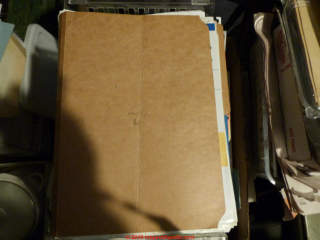
On 2019-09-19 by (mod) -
Look forward to seeing the photo, Steve.
Yep air tests are also unreliable: having conducted and studied quite a few over many years I found up to 4 orders of magnitude in the "counts" obtained. And sometimes there's plenty of mold growing on a surface but not much in the air.
I am waaaay out on a limb on this - in fact I can hear the branch cracking under me as I type - but before I fall smashing to earth, I'll suggest that it'd be unlikely that mold found in the cabinet under a sink would be a large-enough mold reservoir to cause building occupant IAQ or health complaints (except for odd cases like wiping a moldy finger in your own eye).
But the sink leak and mold could be an indicator of a larger leak and mold problem remaining to be found.
Look around.
On 2019-09-19 by Steve
The air quality test came back negative for anything, however. But I have never coughed this long before in my life. I am better, however, I still cough depending on environments that I am in.
Here is the image of what I found under the sink.
On 2019-09-17 by (mod) -
Steve unfortunately Clark Van Oyen's Comments Box lets you upload just one image or photo per comment, but of course you can always just post another comment with another photo.
On 2019-09-17 by (mod) -
Looks like a couple of kinds of mold.
Keep in mind that 90% of molds will not grow in ANY culture whatsoever, so we're roughly 90% "wrong" when depending on cultures to identify mold. So I'm not sure what to make of a count of colony forming units. That's what fell on and liked the mold culture media.
Details are at MOLD CULTURE TEST ERRORS
The good news is it doesn't matter since the genera/species won't change the cleanup needed.
Remove the mold, fix the cause.
On 2019-09-17 by Steve
Green moldy stuff under sink This was under a piece of vinyl that was glued on top of the floor. There was a liver below it too.
Thanks!
On 2019-09-17 by Steve
this is from the area under the sink. where I found the green stuff...I got a 40CFU/ml with this mold.
On 2019-09-17 by Steve
I moved in a rental home in July - (7/22) noticed I started coughing. I thought it was the Summer cold and went about my business. I still had it a week later - went to doc in a box and got a ZPack and Prednisome script and it didn't even dent the cough. I went back - got a chest xray and all is good. Another round of prednisone - didn't help.
I had a master bedroom that had a stink in the room and they changed the carpet out and the stink went away - I waited about a week and I finally slet in there once I got my mattress delivered. I slept in that room one night and when I let my dog out in the middle of the night, I was light headed - my legs were scratchy and when I woke up the next morning. Was feeling disorientated, dizzy, low grade fever, chills, felt like I was getting the flu.
Never slept in there again and it went away. I came home early from work and slept.
I thought this is weird - I got an at home mold test adn got a result - about 14 colonies on a 1 hour settling plate. I did another - where I sit to watch TV and it was a full plate of spores using the same method.
I eventually had the couch swabbed, an area under the kitchen sink where I found some green gunk and in the laundry room there there was a drain that literally was black "gunk" for lack of a better term. I will try and add photos of all these areas (sans the couch).
The landlord also (9 days later), got an air quality test and found little to minimal mold on their 10 minute test. THey said I am "Hypersensitive" to it. I have NEVER had problems like this in any home I have lived. Ever. My asthma has been acting up more than ever and aftyert a little over a couple weeks, I am not coughing and in a new home - but they aren't going to remediate my couch or anything in the home - I am obviously not going to bring that stuff in my home if it was in a home that made me sick.
My results from swabbing were -
My couch >1500CFU/ml
Under sink where a green growth was found: 40CFU/ml
The swab of the drain of black gunk coming out of the hot water unit: >1500CFU/ml
THEIR Air tests were
By couch: Raw: 59 and 393/m
Bedroom where I got sick: Raw 30 and 200/m
Plus I have PLATES that they say are unreliable - my questions are...
I have swab tests by a third party lab AND plates, theirs is an air quality test. I mean proof is on the plates, right?
If there was a mold event in there prior and it wasn't remediated correctly - would I still get sick (or possibly)? Spores would still be present and the house was empty for months before me.
I am allregic to penicillin - would I have a reaction to that mold?
The moisture meter showed nothing in the walls, however, on the slab floor on the masonary reading I was getting 80% moisture plus - is this normal? Especially under flooring or carpet?
I have had several people come in that house adn have various reaction - Eyes watering/burning, Hives, coughing. It seems something is going on and this company is playing it off...
Thanks for your help!
On 2019-08-02 by (mod) -
The photo is a bit blurry but it might be Stemonitis a brown hairy mold. I would clean it up, use any household cleaner to finish the job.Look for evidence of leaks into the floor or wall and if-found we may suggest further investigation.
Read about this mold - if that's what it is - at https://inspectapedia.com/mold/Brown_Hairy_Mold.php BROWN HAIRY BATHROOM MOLD (This fungus is not confined to bathrooms)
On 2019-08-02 by Jen
Found this on our mud room floor on the tile by the baseboard. After research appears to be possibly brown hairy mold? What steps do I need to take? Is it toxic? It is on the floor, but there is a window above it.
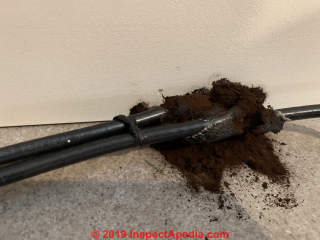
On 2019-05-04 by (mod) -
First, stop vacuuming if there's a possibility that you're simply aerating mold or asbestos particles. Unless you're using a HEPA rated vacuum that's the problem that would be caused.Second in the condition that you describe it sounds as if you need a professional to clean up the floor. You may want to do some settled dust testing of other areas of the house to be sure that you don't need additional cleaning there.
On 2019-05-03 by Kathie
We are cleaning out my mother's house to sell (built 1956) and the majority of the tile flooring was damaged in flooding from last year. The cause of the flooding has been identified and a dehumidifier installed in the area to keep it dry from any further moisture.
We are at a loss of what to do and a bit concerned about working in the area after reading this site. The tiles were significantly damaged and they are cracked and broken throughout the main area when anyone walks in the area which is needed to clean it out. I'm almost 100% certain they contain asbstetos and now worried about the release of asbestos after walking on the cracked tiles. They basically just shatter.
What should we do? We did buy some mold eradication product but not after reading your site, I'm not sure that is a good option. My husband vacuumed the walls and I was going to wash them down with vinegar but unsure what to do with the floors. It will be sold "as is" but I hate having the residual smell of mold in the area. Need advice! Thanks.
On 2019-04-19 by Anonymous
Thank you so much!
On 2019-04-19 by (mod) - cross-contamination after a mold cleanup job has been supposedly completed
AnonWhen your question is about cross-contamination after a job has been supposedly completed, you're left with visual inspection and settled dust sampling of representative areas outside the work area.
If you happened to have samples of the original in-work-area mold to identify the dominant species there that'd have been useful but it's probably not essential.
I can't assume that your area is covered in mold spores top to bottom - with no data.
On 2019-04-18 by Anonymous
Doing some renovations on a house we just bought and just now learned that when they demoed the shower the shower pan had a lot of mold on it. So have to assume spores went crazy into the space during the aggressive work. They had an air scrubber running and, apparently, they took the old pan out in a bag, but the damage was already done as far I can imagine. The room has since been painted. Am I to assume the space is likely covered in spores from top to bottom (including the overhead exhaust duct) and that they are in the paint as well, in a high humidity room no less? How would you approach something like this after the fact?
On 2019-04-16 by Anonymous
Mr.Friedman, you are a mensch.
On 2019-04-14 0 by (mod) -
Thank you for the very generous feedback.Try not to be too chilled or scared of mold because both the anxiety itself is harmful and the price gouging to which you become vulnerable may also hurt.
On 2019-04-13 by Anonymous
Thank you. After posting my question I was reading a bit more about mold and learned a a little about what you shared which is the media hype of "black mold" that has distracted the public from actual facts of import.
I greatly appreciate your extensive knowledge and the generosity with which you share.it. Among so many things I've learned reading what you've written on this amazing site as well as your responses to questions (mine and others), I've come to appreciate the potential dangers of asp pen which, as you note, has super tiny spores and floats in the air with ease. Your image of it acting almost like a gas the way it moves through buildings was chilling.
On 2019-04-13 by (mod) -
Anon
Why are we especially worried about "black mold" ?
Of the 200 mold genera/species that are very commonly-found in buildings (that's a microscopic subset of the millions of mold genera/species that exist), a few are dark and fewer "black" in color, a feature that has not one iota of significance in the toxicity, allergenicity, pathogenicity of mold. There are plenty of harmful molds that are white, red, green, yellow, even chartreuse.
The "black mold" that your expert is almost certainly thinking about - one that received popularity by in-expert media coverage - is going to be Stachybotrys chartarum - S. chartarum evolved to be spread by sticking to the foot of cows tramping through moldy straw. This inappropriately-popular fungus produces a comparatively large sticky and somewhat warty spore that is not easily airborne except when it's exposed to violence, such as during demolition of moldy drywall - that activity sends all sorts of spores airborne.
While that fungus is indeed one that can make people sick, in my experience (since the 1970's) other molds, particularly ones in the Aspergillus family or perhaps Penicillium family worry me a lot more. Those fellows are very small - some down in the 1-2 micron size range. That' may be 1/6 to 1/10th the size of a Stachybotrys chartarum spore. Those teensy fellows are so small that they move in building air like a gas, going all over the place, staying airborne. Inhaled they don't stick in your nose they go deep into the lung - think Aspergillosis - an ugly fungal lung infection that's hard to treat.
In sum the public focus on "toxic black mold" is mis-placed and therefore dangerous - by inviting us to miss other important building mold contaminants by focusing on the ones that are popular and easy to see.
Finally, we do not need to know the genera/species of mold to clean it up. The mold genera/species do not change the cleanup procedures needed one bit.
The mistake of focusing on one particular mold genera species is the risk that at clearance time you only look for the elephant - while rats, skunks, baboons, and coral snakes are running amok in the home.
IMAGE LOST by older version of Comments code - now fixed. Please re-post the image if you can. Sorry. Mod.
On 2019-04-12 by Anonymous
In the midst of a remediation. Have a pretty good mold inspector who made all the right calls so far, including the recommendation to remove the wood along the back wall of an unfinished basement due to suspicion there could be mold behind it since there was a thin band of some staining along the base of the wood. After wood was removed, mold was found on the insulation, which was removed. (All of this under containment, negative air pressure, etc.)
Some patches of mold were found on the particle board behind the insulation and those areas have been removed as well. Contractor will come out next week to replace that wall, etc. Source of moisture appears to have been condensation from plastic that was behind the wall we just had removed. No other source is apparent. (This house is new to us, so don't know much history.)
I asked the inspector (who has been on site throughout the remediation to supervise and inspect, as needed) if the mold found was "black mold." She said it could be especially if the area had been continually damp, but that black mold spores are sticky and it was unlikely they spread prior to or during the remediation. She also said if it was black mold, it wasn't very active because of low levels on MVOC tests we ran previously. However I was reading on this site that MVOC results are not so simple, straight forward, or reliable due to a variety of factors.
Do you concur with the characterization of black mold as sticky and spores less likely to become airborne as compared to, for example, asp pen? Also, if we had "black mold" is there anything the remediator should be doing differently than if it were not black mold?
On 2019-03-15 by (mod) - do I have to get all stains off of moldy wood?
Breezy
For most wood surfaces such as framing or sheathing you
- remove mold that can be physically removed by scrubbing or cleaning
- dry the area
- fix the leak
- optional: apply a fungicidal sealant to improve the moisture resistance of the wood in that area
You do not need to remove all remaining mold "stains" left in the wood as long as you've fixed the cause of mold growth in the first place
On 2019-03-12 by Breezy
Hi, Its taken me a few years to get my house dried in. I had a lot of water issues on the basement concrete coming in from outside for quite awhile. We have finally been able to move in one side of the basement that has been dryer due to the wood stove and dirt work being finished on that side. We sectioned off where we are with a wall/insulation and curtains.
Problem is the west wall where there had been more water the osb started very quickly to form I think from all the condensation what I think is the black mold you are referring to. We sprayed vinegar, then a few days later wiped off a lot of if with bleach and paper towels.
I think we fixed most of the water from coming in by the door that wasn't sealed but there is still some dampness in the corner and lots of humidity. I'm getting a dehumidifier.
Question is how extensive do I need to be with cleaning it off and what other steps can I ensure that it doesn't become a problem or harmful before I add the insulation and drywall. and should I wear a mask and eye protection when entering the room or scrubbing? what would you recommend using to scrub now that I've already but bleach on it.
I can take a picture and include that if you suggest. My dad said it was probably just mildew because it wiped right off but after reading the article it seems like it probably is mold. Any suggestions are much appreciated.
On 2019-02-13 by Anonymous
Thank you. I wish you safe travels home....
On 2019-02-13 by (mod) -
Well heck I dunno. In principle you can seal off an HVAC system from the remediation area - successfully, and that's good practice.
But the job better be right and not fail. I've been in so many remediation jobs where the containment had fallen down -
And of course we don't know the current condition of the HVAC system and its cleanliness.
Watch out: in general about being too aggressive in telling the remediator what to do - they'll do it, and leave all the responsibility of the success or failure of the job on your shoulders.
You want to communicate that they're the experts, they're in charge, and they're responsible for doing it successfully - as well as for not burning down the house.
Left Mexico, now in Houston
On 2019-02-13 by Anonymous
Thank you for responding while traveling. You are amazing! Should I assume that even after what I described that your warning about running the HVAC during the remediation, even if the HVAC is completely sealed, still stands? If so, what do you recommend to keep the house adequately heated so pipes don't freeze during the remediation process which will stretch over 3 or 4 days from start to finish?
On 2019-02-13 by (mod) -
Keep in mind that the molds that you see may not all be the largest or most problematic mold Reservoir.
Until you track down the leaks in the causes of mold growth you don't know all of its extent. You're only describing what's on the external surface.
The inspector was correct be concerned about moldy insulation.
I agree with you that disturbing molding insulation would certainly increase the Airborne mold level.
However relying on the actual number in Airborne mold counts is fundamentally incorrect anyway because of the enormous variability.
I'm not sure what you thinking when you called mold dormant, nor that you could possibly actually know that.
Furthermore that appellation has no useful meaning in considering mold remediation.
It's also the case that even if mold is not actively growing its spores particularly ones like aspergillus can be highly toxic.
I put a person in the household is allergic to mold should not mislead you. Anyone can become affected by mold if there's sufficient exposure.
A very general guideline that you supposed to think about is that a typical remediation plan will call for the cleaning company to remove visibly molding materials and to continue the process until they have achieved a 2-foot or 1 stud Bay margin of clean material. That allows the remediator to set the size of the job to what's actually discovered as the work proceeds.
On 2019-02-13 by (mod) -
Apologies for the typos. Sometimes when I'm traveling I still try to keep up with your questions but I have to dictate to my phone. My phone doesn't always know what I'm saying.
On 2019-02-13 by Anonymous
Thank you. To clarify should it affect your perspective:
The building is not “contaminated.” I'm sorry I didn't make that clear in my post. In the unfinished basement there are 3 small areas of dormant mold, the largest area is about 2' long x 6" wide (and is a place that two different mold inspectors find unclear as to whether it’s dormant mold or just staining on the wood).
The other 2 areas that are dormant old are about 12”x 8”.
Because a person in the household is allergic to mold, the lab results from spore trap tests were relatively high (4100 asp/pen), and there is evidence of mold, the inspector recommended we remediate the basement and that part of that job should include removal of all insulation along the headers to make sure there are no problems behind the insulation.
She is also recommending that we remove a rear wood wall and the insulation behind it to make sure there are no problems there since there is a small bit of staining along the bottom of the wood that suggests there could have been water issue behind it at some point, and perhaps mold.
On the one hand what we're doing seems like overkill and I challenged the mold inspector (who's been extremely thorough in taking the house history, health history, detailed visual inspection, etc) about the asp/pen number since she conducted the tests immediately after disturbing the insulation behind which the mold was found and then set up the equipment in very close proximity to it.
But she argued that the spores were there, irrespective of whether they were disturbed or not and felt that give the lab results, the visual evidence, and the health issues, full remediation was the best course of action. (And as far as we know from asking, neither she nor the remediation company get any kickbacks or have incentives to recommend one way or another.)
As for keeping the house warm during the remediation, they recommended using electric heaters, but I'm not comfortable w/that because it’s a fire hazard. So Plan B was to seal off the HVAC (which is forced hot air) which they planned to do anyway, and to keep it running on a low temp. Since it would be sealed off and there are no returns in the basement, we were told this should eliminate the problem of moving spores throughout the house. But I still felt uncertain about this plan, which is why I posted my question here.
Also, if you could clarify what you mean by the need to "cover the entire building" and hat "Mona" is I would appreciate it.
As always, any and all insights on your part would be most welcome.
On 2019-02-13 by (mod) -
If you run in a forced air heating system in a mold contaminated building you will certainly contaminate the ductwork and the air handler which will make your clean up far more expensive if that system not already contaminated.
There's also a problem that if the mold remediation is not covering the entire building you risk moving Mona contaminated air from one place to another.
If you have hot water heat such as eating baseboards or radiators you can probably run that system.
It's your comfort you to know that this is not a unique problem in that it's a question that has been faced by every mold cleanup company doing work in cold weather. I would expect them to provide auxiliary heat is needed to make sure that your building doesn't have frozen pipes and more damage.
On 2019-02-13 by Anna
I couldn’t find a sub-category to post this, so am posting it here. I have 2 remediation-related questions:
What’s the best and safest approach to doing a remediation during the winter in a cold weather region re: how to keep the house warm during the 3-day period of set up and remediation?
It’s my impression that, ideally, the HVAC system should be turned off during that time frame. If so, running electric heaters, for example, would seem like a questionable option as they would be a fire hazard.
Is it an appropriate recommendation to seal off the HVAC (which would be done anyway) but allow it to keep running assuming there are no air returns in the basement?
Any other ideas? (Note: The remediation will be in the basement, which is where the HVAC is. There are two registers in the basement, but no returns.
What questions should we ask, and more importantly what answers should we listen out for, with respect to how a remediation company protects us against cross contamination, potentially introducing mold from other sites due to improperly cleaned equipment that is brought into our home?
On 2019-01-27 by (mod) -
You can use the Add Image button to add a photo that's already on your computer or if you're using a smartphone you can even click the Add Image button and then with help from a teenager, snap a photo to post - one per comment.
You might want to check the page top EXPERTS DIRECTORY to find a mold cleanup company and if it's a big job, to find an independent inspector to find the mold, define the scope of work, and confirm later that it was done correctly.
I agree that you need to be able to keep water out of the building or no mold cleanup job will work.
MOLD CLEANUP GUIDE- HOW TO GET RID OF MOLD https://inspectapedia.com/mold/Mold_Cleanup_Guide.php is a good prep to allow you to have an idea of the usual approach - against which you can measure people offering to do the work.
Stay away from magic bullets like ozone, sprays, cover-ups.
YOu need to
Find and remove the mold
Fix its cause
On 2019-01-26 by Philomena Novitt
I came here two years ago because I needed to replace my trusty, loved National Boiler, and you were very helpful. (Although I miss the National a lot.
I now need to find someone who can help me deal with terrible black mold? on my basement walls. I have a sump pump which does a pretty good job but the water problem is a nasty one. I think I need to get a second pedestal sump pump to keep on hand or maybe I need two of them. The water comes in along part of one side of the cellar, mostly in one corner and travels along the "trench" to the sump pump.
I don't know how to take a picture to attach, but can ask my daughter to do that. The black mold has made the paint flake off way above the wet area.
Who should I begin with to find out how I need to handle this problem. I don't like to just go to the internet and ask Google.
Thanks a lot.
On 2019-01-19 by (mod) -
Thank you Gabe; we work hard to provide researched, authoritative, and un-biased information so I am really grateful when a reader finds it so.
Other readers: Gabe's reference to other comments from our moderator and from readers are now found at
MOLD CONTAMINATION in BUILDINGS, FAQs-3
inspectapedia.com/mold/Building-Mold-Contamination-FAQs3.php
On 2019-01-16 by Gabe
I love your comments, they are factual and really relevant to the field of Mold assesment and decontamination.
On 2019-01-16 (mod) said:
Thank you Gabe; we work hard to provide researched, authoritative, and un-biased information so I am really grateful when a reader finds it so.
We also welcome corrections, critique, and content suggestions.
On 2019-01-16 by Gabe
I love your comments, they are factual and really relevant to the field of Mold assesment and decontamination.
On 2018-11-28 by (mod) - What do mold test or count results tell us?
Jib
To me your test results are indicative that there's a mold Reservoir somewhere in your building. Further actual visual physical inspection including possibly checking suspect building cavities where there have been leaks is what's needed.
As We explain through this article series mold tests alone are not a reliable indicator of building mold because it's easy to get a false negative. Test results vary enormously just depending on how the test is conducted.
However when a test detects higher than trivial levels of penicillium and aspergillus and none of that in your control or outdoor samples that's certainly suggestive.
What is more reliable and makes more sense is having a competent expert actually examine the building. The expert looks at the building materials, leak history, and other indicators that suggest that there may be hidden mold that needs to be found and removed.
The other important point to understand is that even if a test showed unequivocal evidence of a mold problem in the building you still have to hire someone all over again to tell you where it is and how much cleaning and demolition and mold growth cause repair are required.
On 2018-11-28 by Jib - what do my mold counts mean?
Thank you for helping so many people. Last week I got mold test done in my apartment. Do you see anything to worry about in the following results?
The swab result from Bathroom Vanity is Aspergillus Penicillium: Raw count 28; count/cm2 174. Area Swabbed (cm2): 6.45, Analyzed at 600X Magnification
Following are air sample results; Media: Air-O-Cell, Vol sampled: 150L, Percent of Trace Analyzed: 100% at 600X Magnification.
CONTROL
Ascospores raw count 18 ; 120 Count / M3
Basidiospores raw count 13 ; 87 Count / M3.
Cladosporium raw count 8 ;53 Count / M3
Curvularia raw count 2 ;13 Count / M3
BATHROOM
Ascospores raw count 1; 7 Count / M3
Aspergillus Penicillium raw count 65 ; 433 Count / M3.
Cladosporium raw count 3 ;20 Count / M3
Ganoderma Raw count 1; 7 Count/M3
Myxomycetes Raw count 1; 7 Count/M3
BEDROOM
Aspergillus Penicillium raw count 3 ; 20 Count / M3.
HALLWAY
Aspergillus Penicillium raw count 7 ; 47 Count / M3.
Thank you for your time.
Watch out: while it is possible to give valid general advice, nobody can make a confident, safe statement about just what mold remediation actions are needed from an email alone nor can a simple mold test in air or on surfaces define the extent of mold contamination nor cleanup that may be needed at a building.
...
Continue reading at MOLD CONTAMINATION IN BUILDINGS - topic home, or select a topic from the closely-related articles below, or see the complete ARTICLE INDEX.
Or see these
Recommended Articles
- ACCEPTABLE MOLD LEVEL
- MOLD CONTAMINATION IN BUILDINGS - home - building mold contamination guide: How to Find, Test, Inspect For, Remove, & Prevent Indoor Mold Contamination what to do about harmful indoor mold.
- MOLD DOCTORS - ENVIRONMENTAL MEDICINE
- MOLD / ENVIRONMENTAL EXPERT, HIRE ?
Suggested citation for this web page
MOLD CONTAMINATION in BUILDINGS, FAQs-4 at InspectApedia.com - online encyclopedia of building & environmental inspection, testing, diagnosis, repair, & problem prevention advice.
Or see this
INDEX to RELATED ARTICLES: ARTICLE INDEX to MOLD CONTAMINATION & REMEDIATION
Or use the SEARCH BOX found below to Ask a Question or Search InspectApedia
Ask a Question or Search InspectApedia
Try the search box just below, or if you prefer, post a question or comment in the Comments box below and we will respond promptly.
Search the InspectApedia website
Note: appearance of your Comment below may be delayed: if your comment contains an image, photograph, web link, or text that looks to the software as if it might be a web link, your posting will appear after it has been approved by a moderator. Apologies for the delay.
Only one image can be added per comment but you can post as many comments, and therefore images, as you like.
You will not receive a notification when a response to your question has been posted.
Please bookmark this page to make it easy for you to check back for our response.
IF above you see "Comment Form is loading comments..." then COMMENT BOX - countable.ca / bawkbox.com IS NOT WORKING.
In any case you are welcome to send an email directly to us at InspectApedia.com at editor@inspectApedia.com
We'll reply to you directly. Please help us help you by noting, in your email, the URL of the InspectApedia page where you wanted to comment.
Citations & References
In addition to any citations in the article above, a full list is available on request.
- In addition to citations & references found in this article, see the research citations given at the end of the related articles found at our suggested
CONTINUE READING or RECOMMENDED ARTICLES.
- Carson, Dunlop & Associates Ltd., 120 Carlton Street Suite 407, Toronto ON M5A 4K2. Tel: (416) 964-9415 1-800-268-7070 Email: info@carsondunlop.com. Alan Carson is a past president of ASHI, the American Society of Home Inspectors.
Thanks to Alan Carson and Bob Dunlop, for permission for InspectAPedia to use text excerpts from The HOME REFERENCE BOOK - the Encyclopedia of Homes and to use illustrations from The ILLUSTRATED HOME .
Carson Dunlop Associates provides extensive home inspection education and report writing material. In gratitude we provide links to tsome Carson Dunlop Associates products and services.


